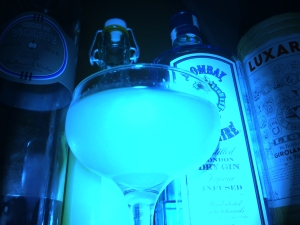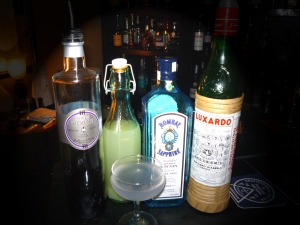Aviation Cocktail
Contributed by on Aug 10, 2014
One reader loves this post.
 The storied history of the rise, fall, and restoration of the Aviation cocktail is one of mystery and misfortune. Legend says that it was first made in 1908, the same year that the Wright Brothers took their first passenger up in the air. Its invention is attributed to Hugo Ensslin, a bartender at New York’s Hotel Wallick, who published the recipe in 1916. The drink was reportedly named in honor of the increasingly popular activity in the skies, represented by the drink’s pale blue color.
The storied history of the rise, fall, and restoration of the Aviation cocktail is one of mystery and misfortune. Legend says that it was first made in 1908, the same year that the Wright Brothers took their first passenger up in the air. Its invention is attributed to Hugo Ensslin, a bartender at New York’s Hotel Wallick, who published the recipe in 1916. The drink was reportedly named in honor of the increasingly popular activity in the skies, represented by the drink’s pale blue color.
However, by the end of the 1920s, the ingredient that gave it that sky blue hue, crème de violette, was not being produced commercially anymore. The Aviation cocktail, being one of its only uses, was apparently not quite popular enough to keep the violet liqueur in demand. In 1930, the wildly popular Savoy Cocktail Book printed a recipe for the Aviation that simply omitted the crème de violette. From there, things got weird. During the many decades when crème de violette was absent from the market, some tried to use other blue liqueurs such as creme Yvette, parfait d’amour, and even (blech) blue curacao as a substitute. Although the color was close, the flavor profile was not there.
Fortunately, in 2007, the Rothman & Winter company began importing crème de violette into the U.S. and the original Aviation once again became available, and a few years later, any bartender worth his bitters has it in his repertoire.
- 2 ounces dry gin
- 1/2 ounce lemon juice
- 1/4 ounce Luxardo maraschino liqueur
- 1/4 ounce crème de violette
Shake with ice and strain into a coupe.
As long as you are investing in that crème de violette, here are a few other things you can do with it. One popular variation on the Aviation is the Blue Moon cocktail, which simply omits the maraschino. Another is the Moonlight cocktail, which uses lime juice instead of lemon and Cointreau instead of maraschino. The Jupiter adds a little fresh-squeezed orange juice to the classic Aviation recipe.
Happy flying.

